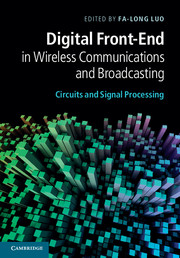Book contents
- Frontmatter
- Contents
- Contributors
- Preface
- Part I Introduction to digital front-end
- Part II DPD and CFR
- Part III DUC, DDC, ADC, DAC, and NCO
- Part IV Digital calibration, imbalance compensation, and error corrections
- Part V Circuits and system integration in digital front-end
- 20 Integration and interface of digital front-end with analog front-end
- 21 Circuits and systems for digital front-ends to support multiple wireless standards
- 22 Programming models and implementation platforms for software defined radio configuration
- 23 Programmable discrete-time integrated receiver front-ends
- 24 Multi-port front-end and transceivers for V-band multi-gigabit/s communication systems
- 25 Cross-layer design and digital front-end for cognitive wireless link
- Index
- References
21 - Circuits and systems for digital front-ends to support multiple wireless standards
from Part V - Circuits and system integration in digital front-end
Published online by Cambridge University Press: 07 October 2011
- Frontmatter
- Contents
- Contributors
- Preface
- Part I Introduction to digital front-end
- Part II DPD and CFR
- Part III DUC, DDC, ADC, DAC, and NCO
- Part IV Digital calibration, imbalance compensation, and error corrections
- Part V Circuits and system integration in digital front-end
- 20 Integration and interface of digital front-end with analog front-end
- 21 Circuits and systems for digital front-ends to support multiple wireless standards
- 22 Programming models and implementation platforms for software defined radio configuration
- 23 Programmable discrete-time integrated receiver front-ends
- 24 Multi-port front-end and transceivers for V-band multi-gigabit/s communication systems
- 25 Cross-layer design and digital front-end for cognitive wireless link
- Index
- References
Summary
Introduction
While the migration of RF circuits running at multi-gigahertz frequencies to low-cost deep-submicron CMOS process has made single-chip wireless transceivers a reality, the proliferation of multiple wireless standards has imposed new challenges of integrating multiple wireless standards on the same hardware. One of the challenges in multi-standard radios is the need to support multiple frequency bands ranging from less than 1 GHz to more than 5 GHz. In this chapter, we will discuss the design of digital front-end (DFE) circuits that are applicable to at least two wireless standards: these include GSM/GPRS/EDGE (GGE) and WCDMA. We will also show how to extend the design to support LTE. Restricting the coverage to only three wireless standards is primarily for the amount of analysis that needs to be performed for each standard.
In the context of a receiver, we will use digital front-end (DFE) to describe digital circuits that bridge the output of an A/D converter (ADC) to a digital base-band (DBB) processor. We will also restrict discussion in this chapter to the case of implementation-friendly direct-conversion receiver (DCR) architecture. This will assume zero intermediate frequency (ZIF) for WCDMA and LTE signals but will allow for very low IF (VLIF) for GGE.
- Type
- Chapter
- Information
- Digital Front-End in Wireless Communications and BroadcastingCircuits and Signal Processing, pp. 620 - 649Publisher: Cambridge University PressPrint publication year: 2011



